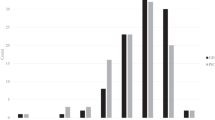Abstract
A collection of Portuguese maize accessions representing a valuable source of genes for introduction into modern cultivars is stored at the Portuguese Plant Germplasm Bank (Banco Português de Germoplasma Vegetal—BPGV). To assess genetic diversity among inbreds, microsatellite analysis was carried out for 54 inbred lines representing the diversity of Portuguese dent and flint maize germplasm. Fifty American and other European elite inbreds were also analysed for comparison. Fifteen microsatellite loci distributed throughout the maize genome were chosen based on their repeat unit and base composition. A total of 80 alleles were detected with an average allele number of 5.33 per locus. Polymorphism information content (PIC) values and observed genetic distances showed the existence of large variability among inbreds. Cluster analysis indicated that almost all of the inbreds could be distinguished from each other and Portuguese inbreds were present in all clusters formed. These associations were consistent with the known pedigree records of the inbreds, confirming a mixed origin of Portuguese materials. Comparative analysis of microsatellite diversity among groups was established according to important traits for both breeding and line identification. This revealed that, although most of the genetic diversity (>95%) was attributable to differences among inbreds of different groups, the existence of phenotypic differentiation in endosperm colour, kernel type and cob colour could be suggested for grouping. These findings support the joint use of molecular and morphological traits in management of the germplasm collection. In this study, SSR markers proved to be effective to characterise and identify maize inbred lines, and demonstrate associations among them.
Similar content being viewed by others
References
Bartlett, M.S., 1937. Some examples of statistical methods of re-search on agriculture and applied biology. J Royal Stat Soc Suppl 4: 137–170.
Botstein, D., R.L. White, M. Sholnick & R.W. David, 1980. Con-struction of a genetic linkage map in man using restriction frag-ment length polymorphisms. Am J Hum Genet 32: 314–331.
Bowcock, A.M., A. Ruiz-Linares, J. Tomfohrde, E. Minch, J.R. Kidd & L.L. Cavalli-Sforza, 1994. High resolution human evolutionary trees with polymorphic microsatellites. Nature 368: 455–457.
Enoki, H., H. Sato & K. Koinuma, 2002. SSR analysis of genetic diversity among maize inbred lines adapted to cold regions of Japan. Theor Appl Genet 104(8): 1270–1277.
Excoffier, L., 1992. WinAMOVA ver. 1.55 – analysis of molecular variance – Graphical Windows 3.x Program for the analysis of population genetic structure from molecular or conventional ge-netic data. Available at: http://anthropologie.unige.ch/LGB/soft-ware/ win/amova/.
Excoffier, L., P.E. Smouse & J.M. Quattro, 1992. Analysis of molec-ular variance inferred from metric distances among DNA haplo-types: Application to human mitocondreal DNA restriction sites. Genetics 131: 479–491.
Frova, C., P. Krajewski, N. di Fonzo, M. Villa & M. Sari-Gorla, 1999. Genetic analysis of drought tolerance in maize by molec-ular markers. I. Yield components. Theor Appl Genet 99: 280–288.
Lu, H. & R. Bernardo, 2001. Molecular marker diversity among current and historical maize inbreds. Theor Appl Genet 103: 613–617.
Mantel, N., 1967. The detection of disease clustering and a generalized regression approach. Cancer Res 27: 209–220.
Matsuoka, Y., S.E. Mitchell, S. Kresovich, M. Goodman & J. Doebley, 2002. Microsatellites in Zea-variability, patterns of mutation, and use for evolutionary studies. Theor Appl Genet 104: 436–450.
Munn, R.H. & J.W. Dudley, 1994. A classification of 148 US maize inbreds. Cluster analysis based on RFLPs. Crop Sci 34(4): 842–851.
Minch, E., A. Ruiz-Linares, D. Goldstein, M. Feldman & L.L. Cavalli-Sforza, 1997. MICROSAT: A Computer Program for Calculating Various Statistics on Microsatellite Allele Data, ver. 1.5d. Stanford University, Stanford, CA. Available at: http://hpgl.stanford.edu/projects/microsat/.
Nei, M., 1978. Estimation of average heterozygosity and genetic distance from a small number of individuals. Genetics 89: 583–590.
Pêgo, S., 1997. Resistance or tolerance? Philosophy may be the answer. In: S. Pêgo & R. Martins (Eds.), Proc. XIX Conf. of the Internat. Working Group on Ostrinia nubilalis and other maize pests, pp. 303–341. Guimarães, Portugal.
Pejic, I., P. Ajmone-Marsan, M. Morgante, V. Kozumplick, P. Castiglioni, G. Taramino & M. Motto, 1998. Comparative analysis of genetic similarity among maize inbred lines detected by RFLPs, RAPDs, SSRs and AFLPs. Theor Appl Genet 97: 1248–1255.
Rebourg, C., M. Chastanet, B. Gouesnard, C. Welcker, P. Dubreuil & A. Charcosset, 2002. Maize introduction into Europe: The history reviewed in the light of molecular data. Theor Appl Genet 106(5): 895–903.
Rohlf, F.J., 2000. NTSYS-pc. Numerical Taxonomy and Multivariate Analysis System, Version 2.1. Exeter Publications, NY.
Romero-Severson, J., 1998. Maize microsatellite – RFLP consensus map. MaizeDB (http://www.agron.missouri.edu).
Saghai-Maroof, M.A., K.M. Soliman, R.A. Jorgensen & R.W. Allard, 1984. Ribosomal DNA spacer-length polymorphism in barley: Mendelian inheritance, chromosomal locations and population dynamics. Proc Natl Acad Sci USA 81: 8014–8018.
Senior, M.L., J.P. Murphy, M.M. Goodman & C.W. Stuber, 1998. Utility of SSRs for determining genetic similarities and relation-ships in maize using agarose gel system. Crop Sci 38: 1088–1098.
Smith, J.S.C., E.C.L. Chin, H. Shu, O.S. Smith, S.J. Wall, M.L. Senior, S.E. Mitchell, S. Kresovich & J. Zeigle, 1997. An evaluation of the utility of SSR loci as molecular markers in maize (Zea mays L.): Comparison with data from RFLPs and pedigree. Theor Appl Genet 95: 163–173.
Stewart, C.N. & L. Excoffier, 1996. Assessing population structure and variability with RAPD data: Application to Vaccinium macrocaropon (American cranberry). J Evol Biol 9: 153–171.
Vigouroux, Y., J.S. Jaqueth, Y. Matsuoka, O.S. Smith, W.D. Beavis, J.S.C. Smith & J. Doebley, 2002. Rate and pattern of mutation at microsatellite loci in maize. Mol Biol Evol 19(8): 1251–1260.
Author information
Authors and Affiliations
Rights and permissions
About this article
Cite this article
Patto, M.V., Satovic, Z., Pêgo, S. et al. Assessing the genetic diversity of Portuguese maize germplasm using microsatellite markers. Euphytica 137, 63–72 (2004). https://doi.org/10.1023/B:EUPH.0000040503.48448.97
Issue Date:
DOI: https://doi.org/10.1023/B:EUPH.0000040503.48448.97




